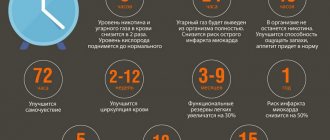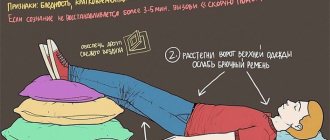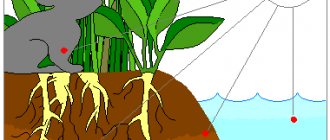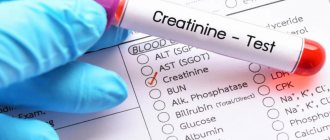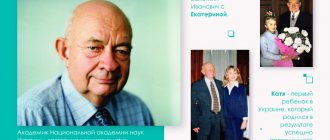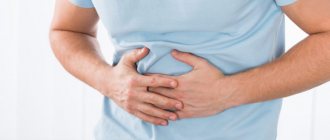The life of the human body is subject to certain rhythms, all processes in it are subject to certain physiological laws. By this unwritten code we are born, live and die. Death, like any physiological process, has its own specific stages of varying degrees of reversibility. But there is also a certain “point of return”, after which the movement becomes only one-way. Terminal (from the Latin terminalis - final, last) are the borderline states between life and death, when the functions of certain organs and systems are gradually and consistently disrupted and lost. This is one of the possible outcomes of various diseases, injuries, wounds and other pathological conditions. Our country has adopted a three-degree classification of terminal conditions, proposed by Academician V.A. Negovsky: pre-agony, agony and clinical death. It is in this sequence that life decays. With the development of resuscitation, the science of reviving the body, a person’s condition after a successfully completed set of resuscitation measures began to be classified as terminal.
Predagonia
An optional period of indefinite duration. In an acute condition - for example, sudden cardiac arrest - it may be completely absent. It is characterized by general lethargy, confusion or coma, systolic blood pressure below the critical level - 80-60 mm Hg, absence of pulse in the peripheral arteries (however, it can still be detected in the carotid or femoral artery). Respiratory disorders - primarily severe shortness of breath, cyanosis (cyanosis) and pallor of the skin. The duration of this stage depends on the reserve capabilities of the body. At the very beginning of preagonia, short-term excitement is possible - the body reflexively tries to fight for life, however, against the backdrop of an unresolved cause (illness, injury, wound), these attempts only accelerate the process of dying. The transition between pre-agony and agony always occurs through the so-called terminal pause. This state can last up to 4 minutes. The most characteristic signs are a sudden stop in breathing after it increases in frequency, dilation of the pupils and their lack of reaction to light, a sharp depression of cardiac activity (a series of continuous impulses on the ECG is replaced by single bursts of activity). The only exception is dying in a state of deep anesthesia, in which case there is no terminal pause.
Terminal states
Characteristics of terminal states
Pregonal state: general lethargy, confused consciousness, blood pressure cannot be determined, there is no pulse in the peripheral arteries, but palpable in the carotid and femoral arteries;
respiratory disorders are manifested by severe shortness of breath, cyanosis and pallor of the skin and mucous membranes. Agonal state: diagnosed on the basis of the following symptom complex: lack of consciousness and ocular reflexes, undetectable blood pressure, absence of peripheral pulse and sharp weakening in large arteries; Auscultation reveals muffled heart sounds; The ECG shows pronounced signs of hypoxia and cardiac arrhythmias.
Clinical death: it is declared at the moment of complete cessation of blood circulation, breathing and shutdown of the functional activity of the central nervous system. Immediately after stopping and stopping the work of the lungs, metabolic processes decrease sharply, but do not completely stop due to the presence of the mechanism of anaerobic glycolysis. In this regard, clinical death is a reversible condition, and its duration is determined by the time the cerebral cortex experiences in conditions of complete cessation of blood circulation and breathing.
It also makes sense to mention such concepts as brain and biological death.
“ Brain death ” as a diagnosis is registered when there is irreversible damage to the cerebral cortex (decortication). However, in the early stages (the first hours and days after clinical death) it is not easy to establish this diagnosis. Currently, it is based on a triad of symptoms:
- Lack of spontaneous breathing (continued mechanical ventilation);
- The disappearance of the corneal and pupillary reflexes, usually corresponding to complete areflexia;
- Extinct bioelectrical activity of the cerebral cortex, recorded as an isoelectric line on the EEG for 3 hours.
Biological death in a generalized form is defined as the irreversible cessation of vital activity, that is, the final stage of the existence of a living system of the body. Its objective signs are hypostatic spots, a decrease in temperature and rigor mortis of the muscles.
Causes of terminal conditions
In practical activities, it is important to establish the pathogenesis of catastrophic impairment of vital functions and, first of all, the mechanism of cardiac arrest in the early stages of revival. The most common causes of sudden death are injuries, burns, electric shock, drowning, mechanical asphyxia, myocardial infarction, acute cardiac arrhythmias, anaphylaxis (insect bite, medication administration).
The pathogenesis of cardiac arrest can vary within the influence of one etiological factor. In mechanical asphyxia, when the loop engulfs above the larynx, a reflex cessation of breathing initially occurs as a result of direct compression of the carotid sinuses. In another situation, large vessels of the neck and trachea may be compressed, and occasionally a fracture of the cervical vertebrae may occur, which gives the immediate mechanism of cardiac arrest a slightly different pathogenetic connotation. In case of drowning, water can immediately flood the tracheobronchial tree, turning off the alveoli from the function of blood oxygenation. In another variant, the mechanism of death is determined by the primary spasm of the glottis and the critical level of hypoxia. With different paths of electric current passing through the body, the mechanism of critical impairment of vital functions varies.
The causes of “anesthesia death” are especially varied: reflex cardiac arrest due to insufficient atropinization of the patient, asystole as a result of the cardiotoxic effect of barbiturates, pronounced sympathomimetic properties of some inhalational anesthetics (fluorotane, chloroform, trichlorethylene, cyclopropane). During anesthesia, the primary catastrophe may occur in the field of gas exchange (“hypoxic death”).
In traumatic shock, blood loss plays a leading pathogenetic role. However, in a number of observations, primary gas exchange disorders (traumas and wounds of the chest), intoxication of the body with products of cellular decay (extensive wounds and crush injuries), bacterial toxins (infection), fat embolism, shutdown of the vital functions of the heart and brain as a result of their direct injury.
The causes of cardiac arrest are usually divided into two groups - cardiogenic and non-cardiogenic.
The first includes myocardial infarction and severe cardiac arrhythmias, much less often - true heart rupture (post-infarction aneurysm), in a cardiac surgery clinic - gross compression of the organ, direct obstruction to blood flow (thrombus, tourniquet, surgeon's finger), embolism of the coronary arteries.
The second group includes the primary catastrophe in extracardiac systems: breathing, metabolism, neuroendocrine sphere. For example, the pathogenetic mechanism of cardiac arrest at the height of a strong psycho-emotional crisis consists of hyperproduction and increased release of catecholamines into the blood (hyperadrenalineemia). Such a stop of a potentially healthy heart is the most favorable option in terms of revitalization and complete restoration of the vitality of the body.
The reversibility of pathological changes is doubtful if cardiac or pulmonary arrest was the result of multiple trauma, severe damage to the skull and brain, massive blood loss with a long period of critical bleeding. The likelihood of restoration of vital functions is low when cessation of blood circulation and breathing occurs against the background of previous hypoxia. In most cases of sudden death of potentially healthy individuals, the average duration of hypoxia is about 3 minutes, after which irreversible changes occur in the central nervous system. In practical resuscitation, they are constantly being revised towards reduction, which is determined by the desire not only to restore blood circulation and breathing as a result of revival, but also to return a person to life as a full-fledged person. The increasing number of people revived every year with irreversible damage to the central nervous system (“social death”) places an increasingly heavy burden on the health service of many countries and calls into question the advisability of revival after complete cardiac arrest for periods exceeding 2-3 minutes. The duration of the reversible state increases significantly (up to 12-15 minutes) after cardiac arrest during drowning in ice water (the protective effect of cold), as well as in children.
Clinical manifestations
The preagonal state is the stage of dying, during which the functions of the cortical-subcortical and upper-stem parts of the brain are gradually disrupted in a descending order, first tachycardia and tachypnea occur, and then bradycordia and bradypnea, blood pressure progressively decreases below a critical level (80-60 mm Hg .st.), sometimes (when dying from asphyxia) after a preliminary significant but short-term rise. At first, general motor excitation, which is of a reflex nature, may be observed; it develops before signs of brain energy deficiency appear and reflects the action of protective mechanisms. Its biological meaning is an attempt to remove the body from a threatening situation. In practice, in the context of the ongoing action of the main causes of death, this excitement contributes to the acceleration of dying. Following the excitation phase, disturbances of consciousness and hypoxic coma develop. At the time of loss of consciousness, signs of energy deficiency are usually still absent, and disturbances of consciousness are associated with changes in synaptic and neurotransmitter processes that have a protective significance.
Impaired consciousness correlates with regular EEG changes. With developing hypoxia, after a latent period, the duration of which depends on the speed of development of oxygen starvation, motor excitation occurs, manifested on the EEG by desynchronization of rhythms. Then, after a short phase of increasing the alpha rhythm, the oscillations on the EEG slow down with the dominance of high-amplitude delta oscillations mainly in the frontal areas. This slowdown, although not absolutely precise in time, coincides with a loss of consciousness. Simultaneously with the loss of consciousness, convulsive activity (tonic paroxysms, decerebrate rigidity), involuntary urination and defecation appear. As the coma deepens, delta activity breaks up into separate groups, separated by intervals of so-called electrical silence. The duration of these intervals increases in parallel with the decrease in the amplitude of oscillations in groups of slow waves. Then the electrical activity of the brain completely disappears. In some cases, with a sudden stop of blood circulation, delta activity does not have time to develop. After complete suppression of the electrical activity of the brain, mainly during rapid dying, short-term convulsions of the decerebrate type may be observed. Suppression of the electrical activity of the brain occurs when cerebral blood flow decreases to approximately 15-16 ml/100 g/min, and depolarization of cell membranes occurs when cerebral blood flow is 8-10 ml/100 g/min. In the interval between these values of cerebral blood flow, the brain no longer functions, but still remains ready to immediately restore its functions in the event of increased cerebral blood flow. The length of the period during which the brain remains fully capable of maintaining its functions is not precisely determined. When blood flow drops below 6 ml/100 g/min, progressive development of pathological changes in brain tissue occurs.
Following the preagonal state, a terminal pause - a state that lasts 1-4 minutes: breathing stops, bradycardia develops, sometimes asystole, pupil reactions to light, corneal and other brainstem reflexes disappear, the pupils dilate. When dying in a state of deep anesthesia, there is no terminal pause. agony develops - the stage of dying, which is characterized by the activity of the bulbar parts of the brain. One of the clinical signs of agony is terminal (agonal) breathing with characteristic rare, short, deep convulsive respiratory movements, sometimes with the participation of skeletal muscles. Breathing movements can also be weak and of low amplitude. In both cases, the effectiveness of external respiration is reduced. The agony, ending with the last breath or the last contraction of the heart, turns into clinical death . In sudden cardiac arrest, agonal breaths may continue for several minutes in the absence of blood circulation.
Clinical death is a reversible stage of dying. In this state, with external signs of death of the body (absence of heartbeats, spontaneous breathing and any neuro-reflex reactions to external influences), the potential possibility of restoring its vital functions using resuscitation methods remains. In a state of clinical death, the ECG records either the complete disappearance of complexes, or fibrillar oscillations of gradually decreasing frequency and amplitude, mono- and bipolar complexes with a lack of differentiation between the initial (QRS waves) and final (T wave) parts. In clinical practice, in case of sudden death in conditions of normal body temperature, the duration of the state of clinical death is determined by the period from cardiac arrest to the restoration of its activity, although during this period resuscitation measures were carried out to maintain blood circulation in the body. If these measures were started in a timely manner and turned out to be effective, as judged by the appearance of pulsation in the carotid arteries, the time between circulatory arrest and the start of resuscitation should be considered the period of clinical death. According to modern data, complete restoration of body functions, including higher nervous activity, is possible even with longer periods of clinical death, subject to a number of influences carried out simultaneously and even some time after the main resuscitation measures. These effects (measures taken to increase systemic blood pressure, improve blood rheological parameters, artificial ventilation, hormonal therapy, detoxification in the form of hemosorption, plasmapheresis, body lavage, exchange transfusion and especially donor cardiopulmonary bypass, as well as some pharmacological effects on the brain) neutralize post-resuscitation pathogenic factors and reliably alleviate the course of the so-called post-resuscitation disease.
It should be borne in mind that the duration of clinical death is influenced by the type of dying, its conditions and duration, the age of the dying person, the degree of his excitement, body temperature during dying, etc. With the help of preventive artificial hypothermia, the duration of clinical death can be increased to 2 hours; with prolonged dying from progressive blood loss, especially when combined with trauma, the duration of clinical death becomes zero, since changes incompatible with the stable restoration of vital functions develop in the body even before cardiac arrest.
Following clinical death comes biological , that is, true death, the development of which excludes the possibility of revival.
Treatment: resuscitation and intensive care
In the early stages of dying, all types of death are determined by the following triad of clinical signs:
- Lack of breathing (apnea);
- Stoppage of blood circulation (asystole);
- Switching off consciousness (coma).
Due to the difficulty of distinguishing between reversible and irreversible conditions, resuscitation should begin in all cases of sudden death and, as the revival progresses, the effectiveness of the measures and the prognosis for the patient should be clarified. This rule does not apply to cases with clear external signs of biological death (hypostatic spots, muscle rigor).
Knowledge of the three techniques of the resuscitation method (ABC rule) is fundamental: Air way open - restore airway patency; Breathe for victim – start mechanical ventilation; Circulation his blood – start cardiac massage.
The diagnosis of complete cessation of spontaneous breathing (apnea) is made visually - by the absence of respiratory excursions. You should not waste precious time applying mirrors, shiny, metallic or light objects to your mouth and nose. Of course, visual diagnosis of apnea requires the resuscitator to be extremely attentive and clear, quick movements.
When the airways are completely obstructed, there is no air flow near the nose and mouth, and when the patient tries to inhale, a depression of the chest and the front surface of the neck is observed. The diagnosis of complete obstruction becomes extremely clear when an unsuccessful attempt is made to perform artificial inspiration under positive pressure. Not only complete, but also partial obstruction of the airways is mortally dangerous, which causes deep brain hypoxia, pulmonary edema and secondary apnea due to depletion of respiratory function.
Emergency restoration of airway patency is achieved by sequentially performing the following measures: the patient is given the appropriate position; the head is thrown back; perform a test injection of air into the lungs. If at this stage mechanical ventilation is unsuccessful, they undertake: maximum forward displacement of the lower jaw, rapid sanitation of the oral cavity and nasopharynx, an attempt at mechanical ventilation through the inserted air duct, immediate elimination of bronchospasm with its symptoms.
Let us explain this principle diagram. The patient should be placed horizontally on his back; during sanitation of the oropharynx, it is advisable to lower the head end. The resuscitator tilts the patient's head back, placing one hand under his neck and the other on his forehead. This forces the root of the tongue to move away from the back wall of the pharynx and ensures the restoration of free access of air to the larynx and trachea. During recovery, the patient's mouth is constantly kept open, since the nasal passages are often clogged with mucus and blood. In order to move the lower jaw forward as far as possible, the patient’s chin is grabbed with both hands; this technique can be performed with one hand by placing the thumb in the mouth of the person being animated. They begin toileting the oropharynx after one or two attempts to perform mechanical ventilation, when they are convinced that there is really an urgent need for sanitation. Using a gauze pad or handkerchief on your finger, you can clean only the upper floors of the airways. Effective aspiration is possible using various vacuum suction devices and rubber catheters with a large internal lumen diameter (0.3-0.5 cm). At the moment of aspiration, the patient’s head and shoulders are turned to the side as much as possible, and the mouth is wide open.
To restore impaired airway patency, it is good to use S-shaped air ducts, which prevent obstruction and keep the root of the tongue pushed forward. However, ducts can easily become dislodged and require constant monitoring. To insert the air duct, the patient's mouth is opened with crossed fingers, and the tube is advanced to the root of the tongue with a rotational movement. If all of the above measures do not lead to the restoration of airway patency, then tracheal intubation and deep tracheobronchial aspiration are necessary for health reasons. However, this effective measure is only available to medical personnel in medical institutions or specially equipped ambulances.
Tracheostomy in case of complete obstruction of the respiratory tract is futile, as it takes more than 3 minutes; In addition, its danger in an emergency situation increases sharply. Tracheal intubation should be preferred over surgery. When the cause of airway obstruction is localized at the entrance to the larynx, emergency cricothyroidotomy or conicotomy is fundamentally permissible in the area of the vocal cords as technically simpler operations.
Mechanical ventilation begins after the airway is restored. Currently, the indisputable advantage of mechanical ventilation using one of the expiratory types (mouth to mouth, mouth to mouth and nose) has been proven over old techniques based on changes in chest volume (according to Sylvester, Schede, Holger-Nielsen). Positive pressure ventilation is based on the rhythmic injection of air exhaled by a resuscitator into the patient’s airways. Taking a deep breath, the resuscitator tightly wraps his lips around the patient’s mouth and blows air in with some effort. To prevent air leakage, the patient's nose is covered with their cheek, hand, or a special clamp. At the height of artificial inspiration, air injection is suspended, the resuscitator turns his face to the side, and passive exhalation occurs. The intervals between individual respiratory cycles should be 5 seconds (12 cycles per minute). You should not try to blow in air as often as possible; it is more important to ensure a sufficient volume of artificial inspiration. When breathing through the nose, the patient’s mouth is closed, the resuscitator tightly clasps, but does not squeeze, the patient’s nose with his lips and blows in air. Swelling of the epigastric region that occurs during positive pressure ventilation indicates air entering the stomach. Then you should carefully press the palm of your hand on the epigastric area, after turning the patient’s head and shoulders to the side.
The use of breathing fur (Ambu bag) improves the physiological basis of artificial ventilation (atmospheric air enriched with oxygen), as well as its hygienic side. When holding the “tight mask” with one hand, the resuscitator’s thumb is located in the nose area, the index finger is on the chin, and the rest pull the lower jaw up and back in order to close the patient’s mouth under the mask. Manual ventilation in an emergency is preferable to automatic ventilation, since unsynchronized pressure on the chest wall during cardiac massage easily interrupts the air pumping of the breathing apparatus. At the next stage of revival, restoration of cardiac activity begins.
The main symptom of cardiac arrest that people focus on is the absence of a pulse in the carotid (femoral) artery. The pulse examination begins after the first three artificial breaths. Its absence is an imperative signal to begin closed cardiac massage. Compression of the heart muscle between the spine and sternum leads to the expulsion of small volumes of blood from the left ventricle into the large ventricle, and from the right into the pulmonary circulation (about 40% of the blood circulation). Massage itself does not lead to oxygenation of the blood, so revitalization can be effective with simultaneous mechanical ventilation. To carry out the massage, the resuscitator is positioned on either side of the patient, places one palm on top of the other and applies pressure to the sternum at a point located 2 transverse fingers above the xiphoid process, at the point where the 5th rib attaches to the sternum on the left.
The depth of the chest wall deflection is 4-5 cm, duration is 0.5 s, the interval between individual compressions is 0.5–1 s. During pauses, the hands are not removed from the sternum, the fingers remain raised, and the arms are fully straightened at the elbow joints. The criterion for correct massage is a clearly defined artificial pulse wave on the carotid (femoral) artery. If the revival is carried out by one person, then after two air injections 15 compressions are carried out; with the participation of two people, the ventilation-massage ratio is 1:5; after tracheal intubation, this ratio is 2:15, regardless of the number of resuscitators. With the appearance of a distinct pulsation of the artery, the cardiac massage is stopped, continuing one mechanical ventilation until spontaneous breathing is restored.
Drug stimulation of cardiac activity should begin as early as possible and be repeated during cardiac massage every 5 minutes. Following adrenaline and calcium chloride, 200 ml of a 2% sodium bicarbonate solution is injected into a vein. In the future, such infusions are repeated every 10 minutes until blood circulation is restored or it becomes possible to control the blood pH. Proven. That intravenous administration of cardiac stimulants against the background of cardiac massage is almost as effective as intracardiac administration. However, the latter method is associated with the risk of direct damage to the myocardium, the conduction system of the heart, and intramural administration of calcium chloride. In this regard, indications for intracardiac administration of substances should be extremely narrowed. Following drug stimulation, electrical defibrillation of the heart begins, which is carried out by a series of successive discharges of pulsed current. They start at a voltage of 3500 V, and then each time increase the voltage by 500 V, bringing it to 6000 V. When a series of successive discharges does not lead to restoration of cardiac activity, solutions of novocaine or novocainamda (1-3 mg/kg), sodium bicarbonate are infused intravenously . Then a new series of shocks is used, which continues either until cardiac activity is restored or until signs of brain death appear. The technique of electrical defibrillation of the heart is simple, but requires great care to prevent electric shock to others. One electrode is placed under the right shoulder blade, the other is pressed forcefully against the chest wall, above the apex of the heart. Gauze wipes moistened with saline solution are placed on the surface of the electrodes. At the moment of the electric discharge, no one touches the patient.
If closed massage is unsuccessful, in some cases open cardiac massage is indicated: with simultaneous chest pathology - cardiac tamponade, severe intrapleural bleeding, tension pneumothorax, cardiac arrest during intrathoracic operations; in the operating room (reanimation room) after a series of unsuccessful attempts at external massage and defibrillation; in case of severe chest rigidity, when external massage is ineffective (lack of artificial pulse wave).
The technique of direct cardiac massage involves an urgent thoracotomy in the fourth intercostal space on the left. A scalpel is used to cut through the skin, subcutaneous tissue and fascia of the pectoral muscles. Next, the muscles are perforated with a forceps and the intercostal space is stretched with your hands. Using a retractor, open the chest cavity widely and immediately begin to massage the heart with one hand so that the thumb is located in front and the rest in the back. After a series of rhythmic compressions, the pericardium is opened, which provides visual diagnosis of fibrillations. On the opened chest, direct electrical defibrillation is performed with a pulsed current of increasing voltage (1500–3000 V). One sterile electrode is placed behind the left ventricle, the other is placed on the anterior surface of the heart. In order to prevent myocardial burns, the electrodes are protected with gauze pads moistened with saline solution.
Sluggish arrhythmic contractions of the hypodynamic myocardium, which has not lost its full contractile ability, serve as an indication for the emergency start of cardiac pacing. Cardiac pacing is promising for acute myocardial infarction, severe cardiac arrhythmia (tachyarrhythmia, bridycardia), damage to the conduction system of the heart (overdose of digitalis drugs) and inadequate blood circulation.
Immediately after the restoration of blood circulation and breathing, they begin to cool the brain, the body as a whole, and administer medications that protect the cells of the central nervous system and other organs from the harmful effects of hypoxia (sodium hydroxybutyrate). During this period, HBOT is indicated. These measures improve the prospects for restoring the functional activity of the central nervous system and are an integral element of the treatment of the “disease of the revitalized body.” Among hypothermia options, preference is given to regional head cooling. In the absence of a special device, ice packs and wet wraps are used. At the same time, mechanical ventilation and parenteral administration of muscle relaxants and antipyretics continue. The administration of substances that depress the central nervous system, both during resuscitation and in the immediate post-resuscitation period, is not recommended. The temperature in the rectum is maintained at 30° C for 3-5 hours to 2-3 days. Cooling is stopped when signs of consciousness appear.
Various complications of resuscitation are associated with deviations from the above methodology. Prolonged tracheal intubation—more than 15 seconds—leads to asphyxia and irreversible cardiac arrest. Another complication - rupture of the lung parenchyma, tension pneumothorax - occurs during forced injection of air under pressure and is more often observed in young children. To eliminate this complication, urgent thoracentesis and drainage of the pleural cavity with tubes of the appropriate diameter are necessary. Unskilled external cardiac massage leads to rib fractures; relatively more often this complication is observed in elderly people. If during closed heart massage the point of maximum pressure on the sternum is excessively shifted to the left, then along with a rib fracture, lung tissue is damaged; if it is displaced downward, then liver rupture may occur; if upward, there is a fracture of the sternum. These complications are currently considered gross violations in the revival technique. They can be avoided by training medical personnel and the public in basic resuscitation skills with mandatory training on dummies (once every 6 months).
The timing of cessation of resuscitation benefits depends on the cause of sudden death, the duration of complete cardiac and respiratory arrest, and the effectiveness of resuscitation benefits. A favorable outcome of revival is foreshadowed by the rapid appearance of corneal and pupillary reflexes, the disappearance of deathly pallor of the skin and mucous membranes, and after this the resumption of blood circulation, spontaneous breathing, and restoration of consciousness. On the contrary, prolonged absence of consciousness, areflexia, and dilated pupils signal an unfavorable prognosis. Resuscitation can be stopped when sequential (3-5 times) all stages of resuscitation have not restored cardiac activity, there is no spontaneous breathing, the pupils remain wide and do not respond to light.
The prognosis is difficult if, during resuscitation, blood circulation is restored, mechanical ventilation continues, but there is no consciousness (deep coma) and there are no conditions for recording and qualified assessment of the EEG. In the early stages of recovery, it is difficult to talk about “brain death” in such patients, although in most cases we are talking about complete decortication and loss of prospects for “social rehabilitation.” Resuscitation assistance in such cases should be continued. Although the delay in recovery of brain stem reflexes is up to 1 hour, and the electrical activity of the brain is up to 2 hours, making the prognosis very doubtful. The likelihood of complete restoration of brain function noticeably decreases if coma persists for more than 6 hours; with a deep coma lasting more than 24 hours, this probability is very small, lasting more than 48 hours is negligible.
Agony
Agony begins with a sigh or a series of short sighs, then the frequency and amplitude of respiratory movements increase - as the brain's control centers are switched off, their functions move to redundant, less advanced brain structures. The body makes its last effort, mobilizing all available reserves, trying to cling to life. That is why, just before death, the correct heart rhythm is restored, blood flow is restored and a person can even regain consciousness, which has been repeatedly described in fiction and used in cinema. However, all these attempts do not have any energy support; the body burns the remnants of ATP, the universal carrier of energy, and completely destroys cellular reserves. The weight of the substances burned during agony is so great that the difference can be detected by weighing. It is these processes that explain the disappearance of those very few tens of grams that are considered the “flying away” soul. The agony is usually short-lived and ends with the cessation of cardiac, respiratory and brain activity. Clinical death occurs.
What does resuscitation study?
What is resuscitation?
This is the science of resuscitation, which studies the etiology, pathogenesis and treatment of terminal conditions.
Terminal conditions are understood as a variety of pathological processes that are characterized by syndromes of extreme depression of the vital functions of the body.
What is resuscitation?
This is a set of methods that are aimed at eliminating syndromes of extreme depression of the vital functions of the body (re - again; animare - revive).
The life of victims who are in critical condition depends on three factors:
- Timely diagnosis of circulatory arrest.
- Immediately begin resuscitation measures.
- Calling a specialized resuscitation team for qualified medical care.
Clinical death
How many books have been written about “life after death”, about those who visited “there” and then returned to share their impressions or convey to people the “higher” knowledge they had acquired. The controversy around this does not subside and will not subside, because it is impossible to prove or disprove it with one hundred percent certainty. The interest in the penultimate stage of human dying is quite understandable. The one whose heart was not beating a couple of minutes ago, whose lungs did not receive air, the one who was actually already dead, after the intervention of doctors, returns to life. The resurrection has been considered a miracle in all centuries. Nevertheless, like any miracle, it has a completely material basis. So, clinical death is determined by three signs: complete cessation of blood circulation, breathing and cessation of brain activity. But all this is still reversible; oxygen-free metabolic processes are still going on in the body. From this moment on, minutes and even seconds count. The faster a set of resuscitation measures is carried out, the greater the chance that it will be possible to return not only a person, but also an individual to life. The fact is that brain neurons, as the most highly specialized cells of our body, are extremely sensitive to a lack of oxygen - hypoxia. And they die very quickly in such conditions. Cell death means the loss of certain functions of the cerebral cortex, which is responsible for higher nervous activity. The lifetime of neurons usually ranges from 2 to 5 minutes; at low ambient temperatures it can even be extended to 12-15 minutes (a classic case is drowning in winter). At a certain point, the number of dead brain cells becomes critical, and then the return of a full-fledged personality becomes impossible, the so-called “social death” occurs. The advisability of resuscitating such patients is the subject of fierce debate not only among doctors, but also among public and religious leaders.
Characteristics
The period of agony, that is, the last struggle, of the body is accompanied by agonal breathing.
Before it there is a pause, in medicine it is called terminal: after the acceleration of excursions, breathing stops completely. During this pause due to hypoxia after tachypnea:
- Loss of brain cell activity
- The pupils become dilated
- Corneal reflexes fade away
When the heart suddenly stops working, there is no preagonal phase.
And in case of fatal blood loss, traumatic shock, or respiratory failure, it can last for several hours. After the described pause, breathing begins in agony.
- First, an inhale appears, very weak, the amplitude is small. Subsequently, inhalations increase slightly, reach their maximum and decrease again.
- Sometimes the inhalations and exhalations are sharp. In a minute, the patient can make 2 - 6 excursions.
- Then breathing stops completely.
What doctors can do
A timely set of resuscitation measures can restore cardiac and respiratory activity, and then a gradual restoration of the lost functions of other organs and systems is possible. Of course, the success of resuscitation depends on the cause that led to clinical death. In some cases, such as massive blood loss, the effectiveness of resuscitation measures is close to zero. If the doctors’ attempts were in vain or no help was provided, true or biological death occurs after clinical death. And this process is already irreversible.
Alexey Vodovozov
Signs of imminent death in a bedridden patient
Inhalations in the agonal state differ from the norm, since they are produced due to the strengthening of muscles from an additional group, that is, the cervical, trunk and oral. At first glance, it may seem that the patient’s breathing is effective, since he inhales deeply and releases all the air.
In fact, the agonal state ventilates the lungs very weakly, at best by 15%. At this moment, the head unconsciously leans back and the mouth opens, as if to swallow air.
These are the last shocks from the breathing center.
Remember!
The agony is considered reversible. You can help your body!
Resuscitation technologies include chest compressions, artificial respiration, the use of an electric defibrillator, the use of muscle relaxants and tracheal intubation, particularly for pulmonary edema. If the patient has significant blood loss, it is important to perform an intra-arterial blood transfusion, as well as plasma replacement fluids.
Sources
- Sepici Dinçel A. Staying calm and teaching biochemistry to postgraduates in COVID-19 times: Pros and cons. // Biochem Mol Biol Educ - 2021 - Vol - NNULL - p.; PMID:33904644
- Cao J., Shen Z.L., Ye Y.J. . // Zhonghua Wei Chang Wai Ke Za Zhi - 2021 - Vol24 - N4 - p.291-296; PMID:33878816
- Panja S., Adams DJ. Urea-urease reaction in controlling properties of supramolecular hydrogels: Pros and Cons. // Chemistry - 2021 - Vol - NNULL - p.; PMID:33861488
- Jastroch M., Polymeropoulos ET., Gaudry MJ. Pros and cons for the evidence of adaptive non-shivering thermogenesis in marsupials. // J Comp Physiol B - 2021 - Vol - NNULL - p.; PMID:33860348
- Zhao Q., Jiang Y., Xiang S., Kaboli PJ., Shen J., Zhao Y., Wu X., Du F., Li M., Cho CH., Li J., Wen Q., Liu T ., Yi T., Xiao Z. Engineered TCR-T Cell Immunotherapy in Anticancer Precision Medicine: Pros and Cons. // Front Immunol - 2021 - Vol12 - NNULL - p.658753; PMID:33859650
- Sura R., Hutt J., Morgan S. Opinion on the Use of Animal Models in Nonclinical Safety Assessment: Pros and Cons. // Toxicol Pathol - 2021 - Vol - NNULL - p.1926233211003498; PMID:33827334
- Ikbal Atli E., Gurkan H., Onur Kirkizlar H., Atli E., Demir S., Yalcintepe S., Kalkan R., Demir AM. Pros and Cons for Fluorescent in Situ Hybridization, Karyotyping and Next Generation Sequencing for Diagnosis and Follow-up of Multiple Myeloma. // Balkan J Med Genet - 2021 - Vol23 - N2 - p.59-64; PMID:33816073
- Mikheev IV., Pirogova MO., Usoltseva LO., Uzhel AS., Bolotnik TA., Kareev IE., Bubnov VP., Lukonina NS., Volkov DS., Goryunkov AA., Korobov MV., Proskurnin MA. Green and rapid preparation of long-term stable aqueous dispersions of fullerenes and endohedral fullerenes: The pros and cons of an ultrasonic probe. // Ultrason Sonochem - 2021 - Vol73 - NNULL - p.105533; PMID:33799110
- Buqué A., Galluzzi L. Preface: Chemical carcinogenesis in mice as a model of human cancer: Pros and cons. // Methods Cell Biol - 2021 - Vol163 - NNULL - p.xvii-xxv; PMID:33785172
- Sanderson SL. Pros and Cons of Commercial Pet Foods (Including Grain/Grain Free) for Dogs and Cats. // Vet Clin North Am Small Anim Pract - 2021 - Vol51 - N3 - p.529-550; PMID:33773644
